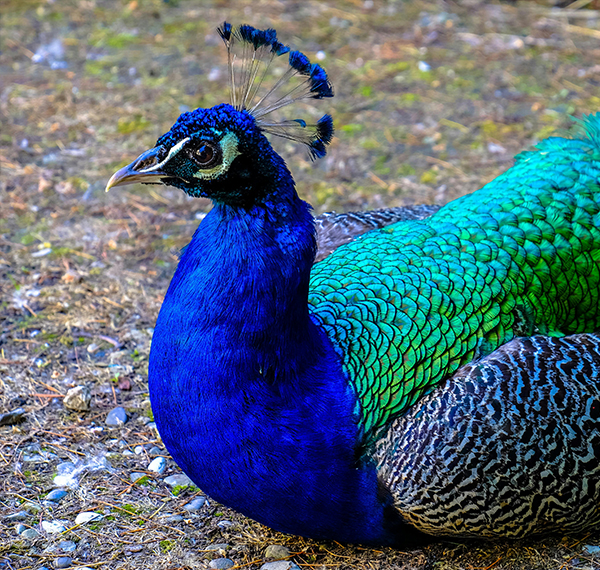Total Weight
Height
Diet
Lifespan
Total Weight
Height
Diet
Lifespan
The Indian peafowl enclosure in Patna Zoo is a spacious and naturalistic habitat, providing ample room for the birds to roam and
display their vibrant plumage. It includes perching areas and a water feature, creating a suitable environment that resembles their natural habitat
in the wild. The enclosure is designed with dense vegetation, shaded resting spots, and open areas to allow the peafowls to move freely.
Proper nutrition is provided with a well-balanced diet, ensuring their health and well-being. Visitors can observe the birds engaging in natural behaviors like foraging, preening, and calling.
The enclosure also features secure fencing to ensure safety while maintaining a peaceful setting.


Pavo Cristatus, commonly known as the Indian Peafowl, is the national bird of India and a symbol of beauty and grace.
Males, called peacocks, have dazzling iridescent blue-green plumage and an impressive fan-like tail adorned with eye-like patterns used
for courtship displays. Females, or peahens, are brownish with a subtle charm. These majestic birds are native to the Indian subcontinent and thrive in forests, grasslands, and near human settlements.
At Patna Zoo, visitors can admire their striking beauty and witness their mesmerizing dance. Peafowls are omnivorous, feeding on seeds, insects, and small creatures,
contributing to ecological balance.
The Indian Peafowl (Pavo cristatus), India’s national bird, is one of the most captivating attractions at Patna Zoo.
Known for its vibrant blue and green plumage, the male peafowl, or peacock, displays an extravagant fan of iridescent feathers during courtship.
| Attribute | Details |
|---|---|
| Weight | Males: Around 4-6 kg, Females: Around 2.7-4 kg |
| Height | Typically around 3.5 to 4.5 feet, including the long tail feathers in males |
| Diet | Seeds, fruits, insects, small reptiles, grains, and plants |
| Lifespan | Around 15-20 years in the wild, and longer in protected environments |
| Conservation Status | Least Concern |
| Population in the Wild | Stable populations across South Asia, especially in India |
| Social Structure | Males are often solitary or in small bachelor groups, while females form small flocks |
| Unique Behavior | Males display their brilliant iridescent tail feathers in elaborate courtship dances |
| Feeding Pattern | Omnivores — foraging throughout the day in open fields, forest edges, and grasslands |
| Feather Feature | Iridescent blue and green plumage, with long, eye-spotted train feathers (males) |
| Closest Relatives | Closely related to pheasants, part of the Phasianidae family |
Peacocks are omnivores, meaning they eat both plant-based foods and small animals. Their diet varies based on their habitat and seasonal availability of food. They primarily feed on fruits, berries, seeds, grains, and tender leaves found in forests and grasslands.
They also consume insects such as ants, termites, and grasshoppers, especially during the monsoon season when insect populations are abundant. In addition, peacocks opportunistically hunt small reptiles like lizards and frogs when available.
This diverse diet helps peacocks adapt to forests, farmlands, and areas near human settlements, making them highly adaptable to changing environments.
Open Now
All visits to Patna Zoo help fund our work both at the zoo and worldwide.